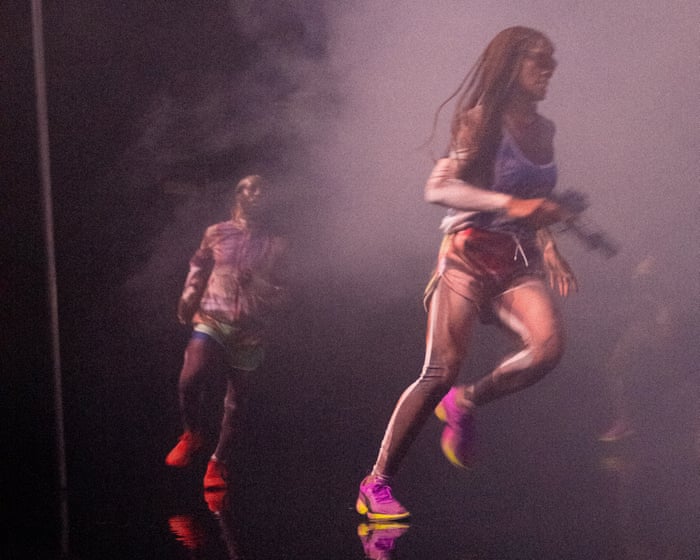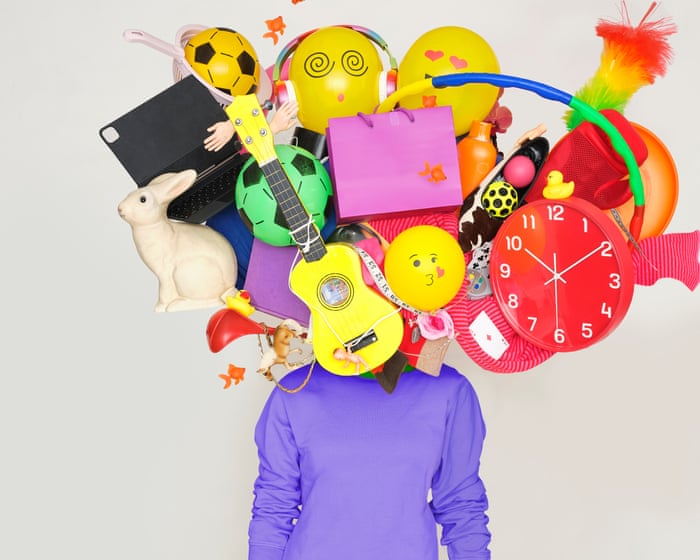In sports, Black athletes are often portrayed as mythical figures—endowed with supernatural speed, exceptional strength, and genetics that seem almost magical. Yet, in everyday life, a Black person running in public can be met with suspicion, fear, or anger. Choreographer Joana Tischkau’s new work, “Runnin’,” which premiered last week at Berlin’s prestigious HAU theater, explores this tension and lays it bare for the audience.
The piece unfolds through everyday actions: four performers move in circles across an empty stage. It brings the “pedestrian movement” of postmodern dance—walking, standing, sitting, movements considered neutral and almost invisible—into conflict with the Black body. The work seems to ask: when a racialized person simply moves or breathes in our shared streets, can that ever be neutral?
The audience was captivated. We were fortunate to witness a dance performance that became a subtle metaphor, a playful reflection of what is currently unfolding in Berlin’s cultural scene. Questions about participation and unconscious bias regarding race and gender no longer seem central to public discourse—not because they’ve been resolved, but because they’ve been quietly sidelined in favor of a hollow neutrality and a return to the status quo.
For a few years, it appeared that Germany’s cultural institutions were undergoing a shift. In the wake of Black Lives Matter and #MeToo, panels on structural racism, gender quotas, and commitments to diversify programming sprang up everywhere. Berlin, ever proud of its progressive image, rushed to become the ultimate model for diversity. And for a while, it was. But now the mood has shifted dramatically.
Across the city, the enthusiasm for “diversity” seems to have waned. The energy and resources once dedicated to anti-racist and inclusive work have faded, and diversity programs are often the first to be cut during austerity measures. At a Berlin arts conference earlier this year, Tischkau remarked, “As a Black German, able-bodied, cisgender woman, I managed to slip through the extremely short window of so-called ‘diversity-sensitive opening.’ A window that is now closing completely… This is not participation. This is anti-democratic… My biography should not be an exception, but the norm.”
This closing window is not just a Berlin story—it’s a global one. In the U.S., the backlash is louder and more radical. Under Donald Trump’s presidency, critical race theory was declared a threat, and diversity training in federal institutions was banned. Universities and school districts are targeted for teaching histories that acknowledge systemic racism. The message is clear: diversity is dangerous.
The same rhetoric is crossing the Atlantic. In Germany, the far-right Alternative für Deutschland (AfD) has labeled diversity and gender politics as “ideological indoctrination.” It attacks cultural institutions that platform marginalized voices, branding them as anti-German and extremist. And increasingly, these views are gaining traction.
But it’s not just the far right’s electoral success or extreme budget cuts driving this regressive cultural shift. The backlash was present from the start, and as I’ve sadly come to realize in various confidential settings over the years, it often comes from within. It comes from many of the people we work with daily—those who identify as progressive, even leftist, and claim to judge a work solely on its “quality,” believing themselves to be completely neutral toward the artist’s identity.
State-funded diversity programs looked good on paper but were always challenging to implement in practice. Many who have worked with these initiatives have faced resistance and skepticism, revealing that the commitment to diversity was often superficial at best.Anyone working within German cultural institutions in recent years can attest to the struggle of convincing colleagues that white, heteronormative, or Eurocentric perspectives are not inherently superior in art. It’s as if we ignore the role of background and knowledge in shaping which artworks we value and which we dismiss. To widen our outlook, we must first recognize which communities and themes are missing from cultural spaces, then actively work to include them through targeted invitations, calls for submissions, and funding.
Yet limited resources in the arts often breed competition, which can devolve into defending entrenched privilege. Initiatives addressing marginalization are quickly dismissed as “woke.” Artists of color are forced to defend their achievements, which are often attributed to quotas rather than talent and hard work. These dynamics usually play out behind closed doors in confidential committees. But when diversity debates go public, they are swiftly exploited by the political right.
Take the 2023 International Literary Prize awarded by Berlin’s Haus der Kulturen der Welt (HKW) to Senegalese author Mohamed Mbougar Sarr. Two jury members later publicly criticized the selection process, claiming identity and race had overshadowed literary merit. They stopped short of saying Sarr was undeserving—which would have been absurd, given his acclaimed novel, The Most Secret Memory of Men, has earned global recognition. Instead, they alleged that white jurors were silenced and white candidates disadvantaged. HKW, known for its decolonial stance, firmly rejected these claims. Still, the statement proved useful to the far-right AfD, which cited it in parliament to challenge public funding for HKW’s “pro-migration” programs and its director’s suitability.
The threat here is not just political—it’s cultural. When institutions abandon diversity efforts preemptively, when funders avoid “controversial” subjects, when artists are told their work is “too specific,” we lose more than representation. We sacrifice truth and complexity. Art should be free to reflect the world as it is, not as the powerful wish it to be.
The anti-diversity backlash isn’t mere fatigue—it’s a deliberate strategy. Like all reactionary movements, it poses as a return to “neutrality.” But that neutrality was always a myth, as powerfully evoked in works like Tischkau’s Runnin’—sometimes without needing to say it outright. We feel it. And that’s what makes art extraordinary.
Frequently Asked Questions
Of course Here is a list of FAQs based on Fatma Aydemirs argument about Germanys resistance to diversity
BeginnerLevel Questions
1 What is the main point Fatma Aydemir is making
She argues that Germanys reluctance to embrace diversity isnt due to simple exhaustion or being overwhelmed Instead its a deliberate strategy that is often presented as being neutral or impartial
2 What does disguised as impartiality mean in this context
It means that the resistance is framed as being fair objective or colorblind For example someone might say I dont see race which sounds neutral but actually ignores the real experiences and systemic disadvantages faced by people of color
3 Can you give a simple example of this calculated approach
A common example is in hiring A company might insist they only hire the most qualified person regardless of background This sounds fair but if their idea of qualified is based solely on traditional German education and networks it systematically excludes talented people from diverse backgrounds
4 Why is this a problem if its presented as being fair
Because this type of fairness often upholds the status quo and ignores existing inequalities It pretends everyone starts from the same place which isnt true True fairness requires actively recognizing and countering these imbalances
Advanced Practical Questions
5 How is this calculated resistance different from outright racism
Outright racism is often loud obvious and intentional This calculated resistance is more subtle and structural It uses the language of neutrality and order to achieve similar exclusionary results without appearing overtly prejudiced
6 In what areas of German society is this most visible
This approach is often seen in
The Education System A reluctance to decolonize curricula or address Germanys colonial history
The Workplace A lack of diversity in leadership positions often explained away by a lack of qualified candidates
Bureaucracy Citizenship Complex inflexible systems that disproportionately disadvantage those without generational knowledge of how they work
Media Culture A tendency to tell stories about minorities rather than having them told by minorities
7 What are the practical consequences of this approach for a diverse society
It leads to a glass ceiling for minorities




